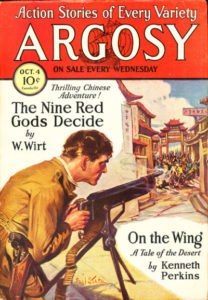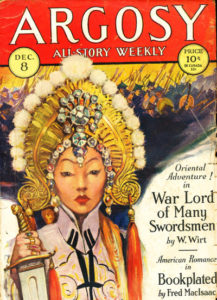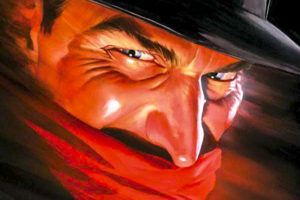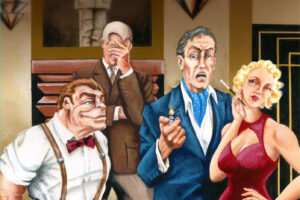 Author W. Wirt (1876-?) was active only in the 1920s and ’30s in the pulps for about 10 years, all writing adventure stories.
Author W. Wirt (1876-?) was active only in the 1920s and ’30s in the pulps for about 10 years, all writing adventure stories.
His main works were the Jimmie Cordie series, along with another series with Captain Norcross, as well as several stand-alone stories. In fact, for a several years, he only wrote Jimmie Cordie stories. Not much is known of him, I’m not able to find many details other than a brief bio he wrote of himself, which has been reprinted in recent collections. In reading this bio, you wonder how much is truth and how much maybe stretched.
Now Altus Press is reprinting the Cordie and Norcross stories as part of its Argosy Library, with the first volumes of these two series.
Jimmie Cordie’s stories ran in several magazines over the years, including Frontier Stories, Argosy/Argosy All Story Weekly, and Short Stories. Few have been collected until now. Cordie and his fellows are soldiers of fortune, and some have said they are an inspiration for Doc Savage. His stories are set in exotic locations like the Far East, Central America, and elsewhere.
The Jimmie Cordie series is made up of the following:
- “He’s a Good Little Guy at That,” Frontier Stories, May 1928 [Blood ‘n’ Thunder 36/37]
- “The Major Wanted Him Alive,” Frontier Stories, June 1928
- “According to My Size and Disposition,” Frontier Stories, October 1928
- “Private Property,” Short Stories, Oct. 10, 1928
- “The Jewel in the Lotus,” Short Stories, Nov. 10, 1928
- “When Tigers Are Hunting,” Frontier Stories, November 1928
- “That Fish Thing,” Frontier Stories, January 1929
- “Right Smack at You!” Frontier Stories, April 1929
- “I’m Shootin’ Vely Good,” Argosy All-Story Weekly, July 13, 1929
- “The River Lies in Front,” Argosy All-Story Weekly, Aug. 17, 1929
- “What Kept You?” Argosy All-Story Weekly, Sept. 28, 1929 [cover feature]
- “The Death Spell of Nong Chik,” Argosy, May 10, 1930
- “The Nine Red Gods Decide,” (three-part serial) Argosy Oct. 4, 11, and 18, 1930 [cover feature]
- “He’s My Meat!” (three-part serial) Argosy Dec. 20, 27, and 30, and Jan. 3, 1931 [cover feature]
- “Jades and Afghans,” Argosy March 28, 1931
- “Aztec Treasure,” Argosy Dec. 5, 1931 [cover feature]
- “War Dragons”, Argosy Aug. 6, 1932 [cover feature?]
- “The Devil’s Tattoo,” Argosy Nov. 12, 1932 [cover feature]
- A Manchu Robin Hood (two-part serial) Argosy Jan. 21 and 28, 1933 [cover feature]
- “The Face in the Rock,” Argosy April 29, 1933
- “Ammunition Up!” Argosy Sept. 16, 1933 [cover feature] [Argosy 2016]
- “The White War Lords,” Argosy Dec. 9, 1933 [cover feature]
- “The Mad Monks,” Argosy July 7, 1934 [cover feature] [Pulp Vault #5]
- “The Assassin” (three-part serial) Argosy Sept. 15, 22, and 29, 1934 [cover feature]
- “Thy Son Grows Cold,” Short Stories Jan. 10, 1935 [High Adventure #162]
- “How Do You Spoke a Gun?” Short Stories May 25, 1935
This first volume reprints the first eight stories, before the series moved mainly to Argosy. Several of the stories for Argosy were even cover featured, which I’ve noted. The cover for “The Nine Red Gods Decide” was used as the cover for the first volume. I’m not sure how many volumes will be needed to reprint the whole series, but think about three or four more volumes. Also noted a few of stories reprinted elsewhere in fanzines.
We meet Jimmie and his associates in these first stories. There is Jimmie, Red Dolan, George Grisby, and Putney. They are all former soldiers, former Legionnaires, former American Expeditionary Forces, and the like. We are told in one story that they have been fighting together for 10 years. In some later stories they are joined by The Fighting Yid (Abraham Cohen) and The Boston Bean (John Cabot Winthrop).
Interestingly, Jimmie doesn’t seem to be the leader of the group. There is no clear leader, and in many of the earlier stories, Red and Jimmie seem about equally important in the stories, and in a few Grisby seems to step up and be in charge. In the later stories set in China, we learn that Jimmie has an in with a Chinese secret society, the Taiping, which helps them in their adventures, so this starts making him more important in the group. I wonder if he becomes more a lead in the later stories, hence naming the series after him and not including others?
We meet the four in the first story as they go after jewels in Malay, and wind up helping a British girl escape her captors. In the next, Jimmie is leading the group in capturing a dangerous gang leader in Texas. The rest of the stories take the group to China. In the third story, they are joined by the Bean and at the end of that story the Yid shows up, and the two come back in the sixth and eight stories.
As noted, Jimmie’s connection with the Taiping society is of use. In most they are after some treasure or riches, but not always. In the fifth story they are again after treasure, but get sidetracked in helping a Chinese warlord and his young daughter fight off a coup attempt by the high priest of his city. The sixth story re-unites them with the young girl, now 10 years older, from the first story. Here they help rescue her father taken prisoner by another secret society. The seventh has the group help a Chinese man known by Jimmie in dealing with a yet another secret society. The eighth story, the longest, has the group heading to western China in search of the tomb of the son of Genghis Khan (here written as Jenghiz Khan).
I’m interested in seeing how this series progresses. In looking over the future stories, it seems they bounce around to different places, but a lot of the stories seem set in China and areas of Asia. And we’ll get some serials, so it will be interesting to see how this group does in longer stories.
A shorter series follows the adventures of Captain John Norcross, formerly of the American Expeditionary Forces in Europe. After the war, he decides to take his regiment on a new adventure to China!
 Norcross has a reputation of obtaining hard to get items. In the first story, “War Lord of Many Swordsman,” a two-part serial in Argosy All-Story Weekly (Dec. 8 and 15, 1928), he is given a new task. He must travel into the western China, a fairly dangerous place, and obtain a strange brass tube. What is in this tube? That’s unknown, but a collector has bankrolled Norcross to obtain it, and a rival has sent someone to get it as well.
Norcross has a reputation of obtaining hard to get items. In the first story, “War Lord of Many Swordsman,” a two-part serial in Argosy All-Story Weekly (Dec. 8 and 15, 1928), he is given a new task. He must travel into the western China, a fairly dangerous place, and obtain a strange brass tube. What is in this tube? That’s unknown, but a collector has bankrolled Norcross to obtain it, and a rival has sent someone to get it as well.
Due to the danger of such a place, and there being a contingent of Zulu warriors (yes!) near the city they must journey to, Norcross decides he must go all out. He rounds up his former regiment, 150 black troops, and finds his cadre of officers, who already live in Asia (how convenient). I thought it interesting that his group includes another “Red,” Red McGee, as well as The Boston Bean and The Fighting Yid (are these the same two from the Cordie series? I think so). Outfitted like a regular army, they head into the interior of China from India.
But along the way they rescue a Manchu princess who has been overthrown by her uncle. Her city is near the one they head to, and it’s the leader of that city who has aided her uncle. So helping her will in a way will help their mission. And so they must contend with Chinese troops as well as those Zulus.
In the end, they succeed and head back to America via India.
But after meeting their backer at the border, and finding out what is in that brass tube, Norcross and his men decide to stay and fight for the princess, now restored to her city, and to have more adventures. The other story in the volume is “Swords Are Out!” a three-part serial in Argosy All-Story Weekly (May 4, 11, and 18, 1929). Set a year later, most of Norcross’ black soldiers have stayed to fight for the princess. Norcross is back in America and his officers have moved on. Because of this, most of the black soldiers become more involved in the story then just being in the background.
But there is danger and intrigue. The new ruler of the neighboring city is conspiring with a Cossack leader to lure the soldiers away and attack the city they guard. Norcross returns before their trap is sprung, and there is the added element of a young Magyar noblewoman. It will be interesting to see how she is handled in future stories.
As I understand it, there are two further series in Argosy from 1930 and 1931, “City of Japheth” and “The Guns of the American,” that comprise the remainder of the series. So we should see a concluding volume with these two. All four of these series were cover featured. The cover from the first is used as the cover for the first volume. And we also get the original interior artwork as well.
I do have to point out that modern readers may be turned off by how Norcross’ black soldiers are handled. They are written as speaking in a rural Southern dialect that may be off-putting, and while treated as free men, the attitude is not as equitable as some would like. For the time period, this was probably better than some, but not at the level of where it could be or what we expect today.
As pulp adventure stores set in exotic lands go, I enjoyed both of these volumes and look forward to more. I would like to know more about Wirt as well. His last work appeared in 1936, which would make him around 60, so perhaps he passed away. How much of what he wrote was based on his life, as with some adventure writers? Or were his claims about himself exaggerated, as with other adventure writers?




Your comments